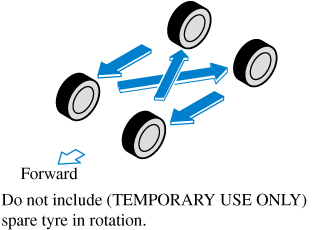Tyre Rotation
Rotate tyres periodically:
Irregular tyre wear is dangerous. To equalize tread wear for maintaining good performance in handling and braking, rotate the tyres every 10,000 km (6,250 miles), or sooner if irregular wear develops.


During rotation, inspect them for correct balance.
Because your vehicle is not equipped with a spare tyre, you cannot do a tyre rotation safely with the jack that comes with your vehicle. Have an expert repairer, we recommend an Authorised Mazda Repairer perform tyre rotation.



Also, inspect them for uneven wear and damage. Abnormal wear is usually caused by one or a combination of the following:
-
Incorrect tyre pressure
-
Improper wheel alignment
-
Out-of-balance wheel
-
Severe braking
After rotation, inflate all tyre pressures to specification (Search) and inspect the wheel nuts for tightness.
(With tyre pressure monitoring system)
After adjusting the tyre pressure, initialization of the tyre pressure monitoring system is necessary to make the system operate normally.
Refer to Tyre Pressure Monitoring System Initialization (Search).
Rotate unidirectional tyres and radial tyres that have an asymmetrical tread pattern or studs only from front to rear, not from side to side. Tyre performance will be reduced if rotated from side to side.
(With limited-slip differential)
Do not use the following:
-
Tyres not of the designated size
-
Tyres of different sizes or types at the same time
-
Tyres not sufficiently inflated
If these instructions are not followed, the rotation of the left and right wheels will be different and will thus apply a constant load on the limited-slip differential.
This will cause a malfunction.




 Read this first
Read this first



















